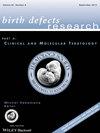Evaluation of the Western Australian Register of Developmental Anomalies: Thirty-five years of surveillance
Abstract
Background
The birth defects component of the Western Australian Register for Developmental Anomalies (WARDA-BD) was evaluated to assess its efficiency, effectiveness, and data quality.
Methods
WARDA-BD was evaluated using the Centers for Disease Control and Prevention 2001 Guidelines for Evaluating Public Health Surveillance Systems and Data Quality Standards from the National Birth Defects Prevention Network. The evaluation included interviews with Register staff, local community organizations, parents, clinicians, and researchers; process observation; and secondary data analyses.
Results
WARDA-BD is a statutory, statewide, population-based surveillance system established in 1980 that monitors approximately 30,000 births annually. Identification of eligible cases is for children up to age 6 years through active and passive ascertainment methods from multiple sources including birth, death, and hospitalization data; antenatal ultrasonography; hospital unit logs; medical records; fetal medicine departments; cytogenetic laboratories; specialty clinics; and pediatric surgery and pathology departments. Defect diagnoses are verified and coded using the 5-digit British Paediatric Association extension of the International Classification of Disease, Ninth Revision system. Register staff monitor Register data for completeness and accuracy resulting in high quality data with a low percentage of missing items.
Conclusion
Strengths of WARDA-BD include high data quality, timeliness, representativeness, stable funding, active community engagement, and high staff retention. Its data were used in numerous epidemiologic investigations resulting in >325 peer-reviewed publications. Potential weaknesses include the limited number of variables collected and low visibility. Although WARDA-BD uses labor intensive case ascertainment and quality assurance and control processes, the Register provides accurate and essential data for stakeholders. Birth Defects Research (Part A) 106:894–904, 2016. © 2016 Wiley Periodicals, Inc.

 求助内容:
求助内容: 应助结果提醒方式:
应助结果提醒方式:


